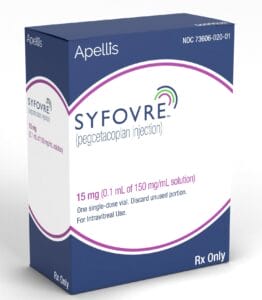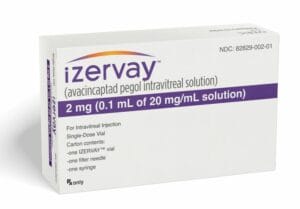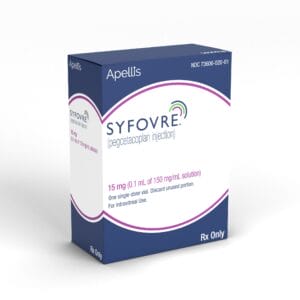August 23, 2023
The retina world continues to make headlines as we move into the fourth quarter of 2023; not all of it has been good news. In February, we saw the U.S. Food and Drug Administration (FDA) approval of the first drug to treat geographic atrophy (GA), pegcetacoplan, which goes by the brand name SYFOVRE. Then, on Aug. 4, the FDA approved the second GA treatment, Izervay (avcinacaptid pegol).
The approval of pegcetacoplan in February came with great fanfare for being the first drug for the treatment of GA, but not all retinal specialists were quick to jump on board. The main issue was that the therapeutic effect of pegcetacoplan was not as robust as hoped. The treatment, given monthly or every other month, did not “cure” GA, nor did it stop the progression. Rather, it just slowed it down with the hope that patients would be able to keep or maintain good functional vision. That alone seems like it would be enough, but given the burden of treatment, the results were considered underwhelming.
The OAKS and DERBY were parallel Phase 3 studies that compared monthly and every ot her month (EOM) injection of pegacetacoplan vs. sham. After one year, the OAKS study showed statistically significant reductions in GA lesion growth vs. sham in the monthly and EOM arms by 22% and 16%. Unfortunately, the DERBY study did not reach statistical significance, showing only a 12% and 11% reduction in GA lesion growth in the monthly and EOM arms, respectively.1 If patients could get past the first year of treatment, however, then a more significant treatment affect could be seen. At 18 and 24 months, DERBY showed a 36% monthly and 29% EOM reduction in GA progression. OAKS had 24% monthly and 25% EOM reduction in slowing GA progression.2 In other words, to really see a significant benefit in slowing the growth rate of GA, patients would need to be treated at least through 18 months, and after that there becomes a more meaningful benefit.
her month (EOM) injection of pegacetacoplan vs. sham. After one year, the OAKS study showed statistically significant reductions in GA lesion growth vs. sham in the monthly and EOM arms by 22% and 16%. Unfortunately, the DERBY study did not reach statistical significance, showing only a 12% and 11% reduction in GA lesion growth in the monthly and EOM arms, respectively.1 If patients could get past the first year of treatment, however, then a more significant treatment affect could be seen. At 18 and 24 months, DERBY showed a 36% monthly and 29% EOM reduction in GA progression. OAKS had 24% monthly and 25% EOM reduction in slowing GA progression.2 In other words, to really see a significant benefit in slowing the growth rate of GA, patients would need to be treated at least through 18 months, and after that there becomes a more meaningful benefit.
Retinal Specialists Proceeding with Caution
Though clearly a benefit in the treatment of GA with pegcetacoplan, many retinal specialists had reservations. Some wanted to wait and hear from their peers regarding their experiences with the medication while others wanted to be sure the drug was safe. Even though there were no significant safety concerns in the clinical trials, that doesn’t always mean there won’t be issues once the drug starts becoming widely used. Indeed, this was seen after brolucizumab (Beovu) was FDA approved for treating neovascular AMD.
Brolucizumab is an anti-VEGF medication that was shown to be just as good as the currently available anti-VEGF drugs but more durable, resulting in patients needing fewer injections. It sailed through clinical trials without any major safety issues and was immediately widely adopted by the retina community. Unfortunately, four months after FDA approval, 14 cases of retinal vasculitis were reported, 11 of which were designated as occlusive retinal vasculitis. Sadly, as good as brolucizumab was, most retinal specialists have avoided using it due to the potential safety concerns.
Incidence of Severe Intraocular Inflammation Very Low but Concerning
Which brings us back to pegcetacoplan. On Saturday, July 15, an email from the American Society of Retinal Specialists was sent to its members warning of potential safety concerns. There were six cases of intraocular inflammation (IOI) resulting in occlusive retinal vasculitis that were reported and for their members to be on the lookout. The episodes occurred after the first injection between day seven and 13 following injection. As you would imagine, this has “spooked” the retina community, even though the incidence of severe IOI is exceedingly low, estimated to be about 1 in 10,000 with over 80,000 injections since its release; lower than even endophthalmitis.
At this point, it remains to be seen if more cases will occur and/or if the retina community will decide that the risk of IOI is too great given the efficacy of the drug. Fortunately, there is hope as now a second drug for the treatment of GA, Izervay (avcinacaptid pegol) was just approved.
Avcinacaptid pegol, like pegcetacoplan, is a complement inhibitor that  blocks C5, which is further down in the complement pathway. The ultimate goal of all the complement inhibitors is to prevent activation of membrane attach complex (MAC). Once MAC is activated, it leads to cell death, lysis, and inflammation in addition to other deleterious effects, including activation of VEGF. It appears, based on the Phase 3 clinical trials, that avcinacaptid pegol may be more effective at slowing GA progression than pegcetacoplan. Results from the GATHER1 study showed a 35% reduction in GA growth vs. the sham at one year. The treatment effect was not as good in the GATHER2 trial where the reduction in GA growth was 17.7% vs. the sham.3 Both studies met the prespecified one-year primary endpoints. Of significance, the only adverse event that was reported in both the GATHER1 and GATHER2 studies was one patient who developed IOI, but it was mild and transient.
blocks C5, which is further down in the complement pathway. The ultimate goal of all the complement inhibitors is to prevent activation of membrane attach complex (MAC). Once MAC is activated, it leads to cell death, lysis, and inflammation in addition to other deleterious effects, including activation of VEGF. It appears, based on the Phase 3 clinical trials, that avcinacaptid pegol may be more effective at slowing GA progression than pegcetacoplan. Results from the GATHER1 study showed a 35% reduction in GA growth vs. the sham at one year. The treatment effect was not as good in the GATHER2 trial where the reduction in GA growth was 17.7% vs. the sham.3 Both studies met the prespecified one-year primary endpoints. Of significance, the only adverse event that was reported in both the GATHER1 and GATHER2 studies was one patient who developed IOI, but it was mild and transient.
Interestingly, the rate of choroidal neovascularization (CNV) development was significantly higher in the eyes treated with avinacaptid pegol at 9% in GATHER1 and 7% in GATHER2, compared to the sham group, which was much less. This was also higher than what was seen with pegcetacoplan, which was 5%.
ECPs Weighing Risks versus Benefits
So, within a period of five months we now have two treatments for geographic atrophy. Neither drug represents a cure but rather just slows down the growth rate. Avcinacaptid pegol appears to be slightly more effective, but the risk of CNV is higher compared to pegcetacoplan. On the other hand, there appears to be higher risk of IOI with pegacetacoplan, but it’s a very small risk and still too early to tell if we will see cases of IOI once avcinacaptid pegol starts to get widespread use. In the meantime, retinal specialists are still figuring out which patients with GA to treat while considering the risk of vision loss (to one or both eyes), burden of treatment given the age and health of the patient, and potential risks.
From an optometry perspective, when should these patients be referred to the retinal specialist? At the very least, it’s important to make our patients aware that there are treatments for GA and for them to understand the risks and benefits. Certainly, those who have already lost central vision in one eye will be more motivated to be treated. The challenge will be helping patients understand it may take several months for them to receive the “benefit” from the treatment. A benefit, by the way, they won’t completely ever realize if the treatment proves to be successful by allowing them to keep and/or maintain central vision. On the other hand, helplessly watching them slowly progress and lose vision by doing nothing is not an acceptable option either. It will be interesting to see how the next several months play out in the world of geographic atrophy.
References
1 Apellis. Apellis announces pegcetacoplan showed continuous and clinically meaningful effects at month 18 in phase 3 DERBY and OAKS studies for geographic atrophy (GA). Accessed January 11, 2023
3 Khanani AM, Patel SS, Staurenghi G. et al. The Efficacy of Avacincaptad Pegol in Geographic Atrophy: GATHER1 and GATHER2 Results. Retina Society 2022.





